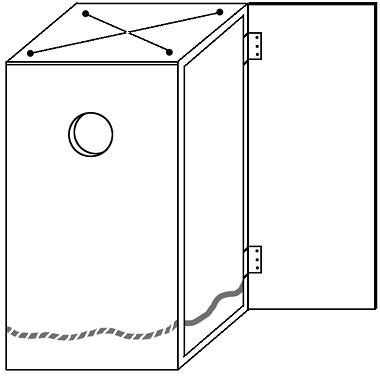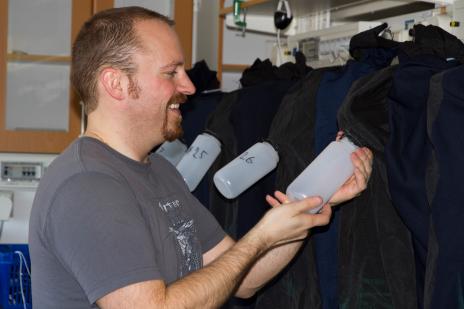Material and methods
Box design

The boxes, 43 in total, were made of oak wood, 25 mm thick walls and roof and 50 mm thick bottom. The size of the boxes were 0.70m x 0.30m x 0.30m, which gives a volume of about 60 L. A circular orifice, 80 mm in diameter, was created on the front of the boxes (Figure 1). The roof had a cross milled into it with four drilled holes (8 mm in diameter) at the endpoints of the cross, in order to let some rain water in and resemble the conditions in hollow oaks. The roof and one side of the box could be opened. Behind the side of the box there was a transparent plastic window for eventual wood mould activity studies. To retain some of the moisture the bottom of the box was covered with 50 mm of clay formed as a bowl.
The boxes were filled to 70 % with a mix of oak saw dust, oak leaves, hay, lucerne flour and 5 L water, as a potential substrate for saproxylic organisms. In addition, boxes were filled with one of four different substrates: 1) a dead hen (Gallus domesticus), 2) 1 L of chicken dung, 3) 1 L additional lucerne flour plus 1 L of oat flakes and 4) five potatoes. The boxes were suspended on oak trunks, approximately 4 m from the ground, with a metallic band that was attached to the backside of the boxes. To minimize differences in microclimate between the boxes and to create a relatively stable environment over time the boxes were positioned on the shadiest side of the oaks.
Study sites and field duration
The study locations, Bjärka-Säby, Brokind and Grebo, are situated about 15-20 km south, south-east of Linköping, Sweden. The distance between the locations was 10-20 km. The area harbours a species-rich saproxylic invertebrate fauna living in old hollow oaks. About 50-100 hollow oaks stood in the core area of each of the three locations.
Each study location consisted of a core area and two or three surrounding sites where the boxes were placed. The surrounding sites were situated within a distance of 100 to 1800 m from the core area. The surrounding sites were selected in different directions from the core area, which resulted in 100 to 2000 m distances between the sites. The boxes in the core areas were placed on old hollow oaks and the boxes in the surrounding sites were placed on younger oaks. To ensure that the core areas were the nearest dispersal source for saproxylic species, the areas around the surrounding sites were thoroughly searched for hollow trees.
The boxes stayed in the field for ten years, but had different starting years (Brokind: 2002, Bjärka Säby: 2003, Grebo: 2004). Hence the full study continued from 2002 to when the last boxes where taken down permanently in 2013. For financial reasons the boxes at Grebo (n=18) only stayed in the field for nine years and were taken down 2013. Henceforth, boxes from the tenth year, from Brokind and Bjärka Säby, and the Grebo boxes (ninth year) will be referred to as the “final year”.
Sampling of invertebrates

Pitfall traps were placed in the boxes the second and third year and in the fourth and final year sampling was made in the boxes by using an eclector trap. The boxes were covered and sealed with a dark bag made of cloth. A hole was made in the cloth bag approximately in front of the orifice and a white but half transparent plastic bottle was placed at the exit hole (Figure 2).
The beetle species were classified as obligate saproxylic (species that exclusively lives on dead wood or on saproxylic organisms) or facultative saproxylic (species that may use dead wood or saproxylic organisms but also other organic substrates) or none of the above (beetles that have no saproxylic preference). The saproxylic beetle species were classified after which microhabitat they are associated with. The classes are: tree-hollow species (wood mould larvae development; rotten wood exclusively in hollows), wood rot species (rotten wood in any part of the trunk, even on the outside), nest species (nests from birds or other animals in tree hollows), dry wood species (dead, dry wood in trunks) or fungi species (fruiting bodies of saproxylic fungi). The study focused on saproxylic beetles but also includes pseudoscorpions since they also requires hollow trees.
Statistics
Comparisons were made between year four and the final year since the same method was used to sample the species these years. However, in the comparisons between boxes and living hollow oaks, the captures from all years in the boxes were used. Comparisons were made with the total amount of species and specimens.
The effects of time (years), distance from core area (DFCA), and substrates was tested on the beetles with a Generalized Linear Models for Multivariate Abundance Data (manyGLM).
A Nonmetric Multidimensional Scaling (NMDS) was used to visualize similarities between the species composition in the boxes and in 90 hollow oaks from a published study. They did not identify all families of saproxylic species in that study, thus to make the two datasets comparable, the families Latrididae, Nitidulidae and most of Staphylinidae were left out from the current data set.
Finally, species-wise odds ratios were calculated (odds of finding species X in a box that year). An odds ratio is calculated on the proportion presence-absence.
Responsible for this page:
Director of undergraduate studies Biology
Last updated:
05/08/15
